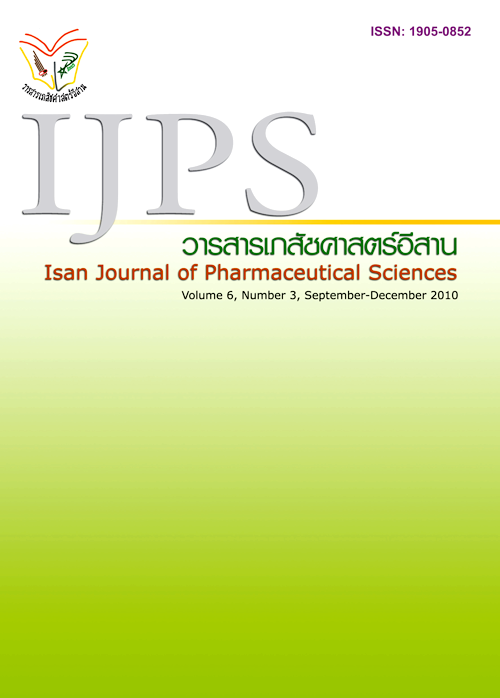A Feasibility Study of Alcoholic-Alkaline Treated Glutinous Rice Starch for Film Coating
Main Article Content
Abstract
The objectives of this research were to study the properties of alcoholic-alkaline treated glutinous rice
starch (AGS) and to investigate the properties of AGS free film and AGS coated tablets using propranolol
hydrochloride as a model drug. The film forming properties of AGS were compared with those of hydroxypropyl
methylcellulose E15LV (HPMC). The result showed that starch granule and gelatinization endotherm of AGS
was not appeared. This indicated that AGS was amorphous form, which was confirmed by powder XRD. The
swelling capacity and solubility of AGS in phosphate buffer pH 6.8 (PB 6.8) and 0.1 M HCl were higher than
those in distilled water (PW). The solubility of AGS film in PB 6.8 and 0.1 M HCl, was not different, but higher
than that using PW. The moisture adsorption and moisture permeability of AGS film were similar to HPMC film.
The moisture adsorption, disintegration time and T50% of the AGS coated tablets were similar to the HPMC
coated tablets. However, the AGS coated tablets showed rougher film surface than the HPMC coated tablets. It
can be concluded that AGS can be used as a film former and it displayed strong feasibility for film coating of
tablets.
Article Details
In the case that some parts are used by others The author must Confirm that obtaining permission to use some of the original authors. And must attach evidence That the permission has been included
References
Bourtoom T. Plasticizer effect on The Properties of Biodegradable Blend Film from Rice Starch-Chitosan. Songklanakarin Journal of Science and Technology 2008; 30 Suppl 1:149-165.
Chen J, Jane J. Preparation of Granular Cold-Water-Soluble Starches Prepared by Alcoholic-Alkaline Treatments. Carbohydrates, Cereal Chem 1994 (a); 71(6): 618-622.
Chen J, Jane J. Properties of Granular Cold-Water-Soluble Starches Prepared by Alcoholic-Alkaline Treatments. Carbohydrates, Cereal Chem 1994 (b); 71(6): 623-626
Iturriaga L, Lopez B, Anon M. Thermal and Physicochemical Charecterization of Saven Argentine Rice Flour and Starches. Food Research International 2004; (37): 439-447.
Kadan R, Champagne E, Ziegler G, et al. Amylose and protein contents of rice cultivars as related to texture of rice-based fries. Journal of Food Science 1997; 62(4): 701-703.
Laovachirasuwan P, Peerapattana J, Srijesdaruk V, et al. The physicochemical properties of a spray dried glutinous rice starch biopolymer. Colloids and Surfaces B: Biointerfaces 2010; (78):30-35.
Mali S, Grossmann M, Garcia M, et al. Effects of controlled stroage on thermal, mechanical and barrier properties of plasticized films from different starch sources. Journal of Food Engineering 2006; (75): 453-460.
Nagai T. Applications of HPMC and Aqueous Film Coating of Pharmaceutical Dosage Forms. Aqueous Polymeric Coatings for Pharmaceutical Dosage Forms. Texas: Dekker;1989. 81-152.
Mony C. and Lefort des Ylouses D. Comparative study of film formers for coating purposes. II. Study of films. Journal de pharmacie de Belgique1978 Mar-Apr; 33(2): 86-98.
Peerapattana J, Phuvarit P, Srijesdaruk V, et al. Pregelatinized glutinous rice starch as a sustained release agent for tablet preparations. Carbohydrate Polymers 2010; (80):453-459.
Pongjanyakul T, Puttipipatkhachorn S. Alginate-magnesium aluminium silicate films: Effect of Plasticizers on Film Properties, Drug Permeation and Drug Release from Coated Tablets. International Journal of Pharmaceutics 2007; (333): 34-44.
Remunan-Lopez C, Bodmeier R. Mechanical, Water uptake and Permeability Properties of Crosslinked Chitosan Glutamate and Alginate Films. Journal of Controlled Release 1997;(44): 215-225.
Seitz JA, Mehta SP, Yeager JL. Tablet coating. In: Lachman L, Lieberman HA, Kanig JL, editors. The Theory and Practice in Industrial Pharmacy, 3rd ed. Lea & Febriger. Philadelphia; 1986: 346-373.
The United States Pharmacopeia and The National Formulary USP 31 NF 26. United States Pharmacopeial Convention: Rockville, MD;2008.


